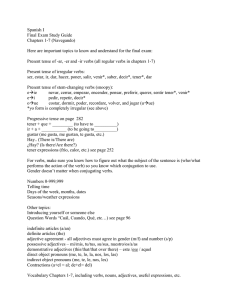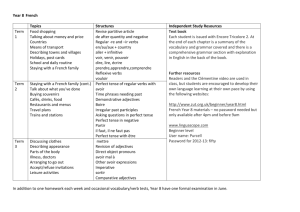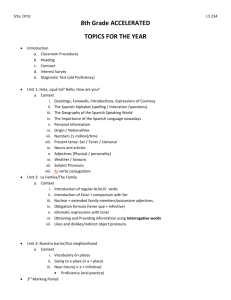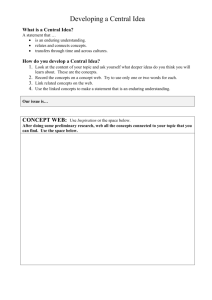Spanish I Final Exam Study Guide Chapters 1-7 (Navegando)
advertisement
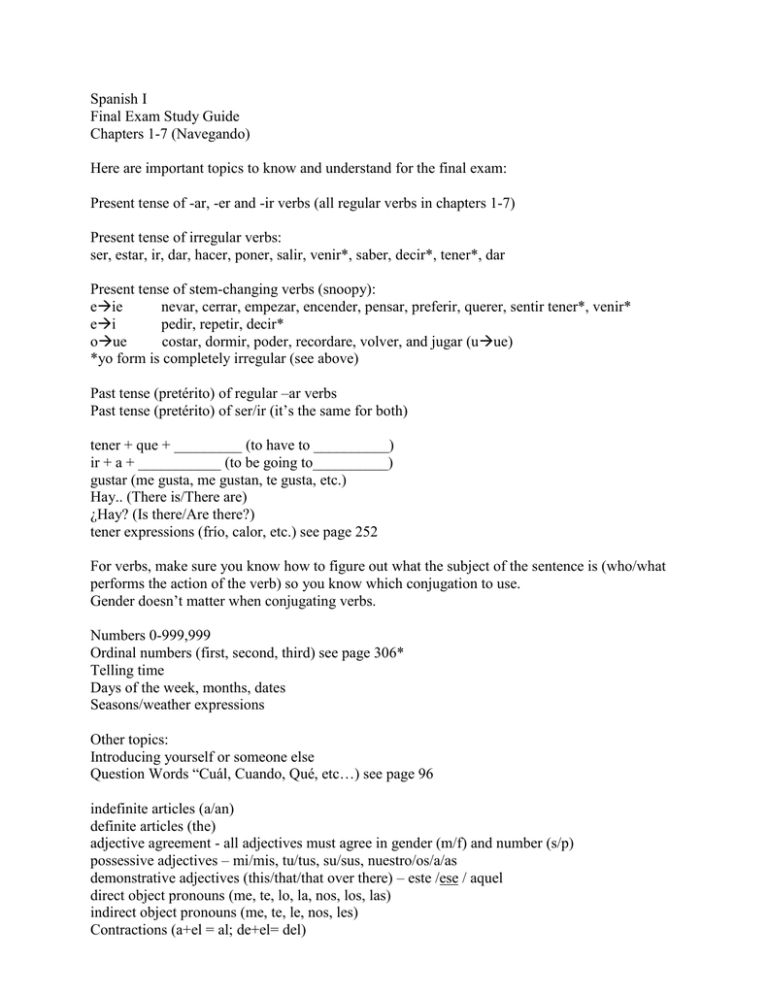
Spanish I Final Exam Study Guide Chapters 1-7 (Navegando) Here are important topics to know and understand for the final exam: Present tense of -ar, -er and -ir verbs (all regular verbs in chapters 1-7) Present tense of irregular verbs: ser, estar, ir, dar, hacer, poner, salir, venir*, saber, decir*, tener*, dar Present tense of stem-changing verbs (snoopy): eie nevar, cerrar, empezar, encender, pensar, preferir, querer, sentir tener*, venir* ei pedir, repetir, decir* oue costar, dormir, poder, recordare, volver, and jugar (uue) *yo form is completely irregular (see above) Past tense (pretérito) of regular –ar verbs Past tense (pretérito) of ser/ir (it’s the same for both) tener + que + _________ (to have to __________) ir + a + ___________ (to be going to__________) gustar (me gusta, me gustan, te gusta, etc.) Hay.. (There is/There are) ¿Hay? (Is there/Are there?) tener expressions (frío, calor, etc.) see page 252 For verbs, make sure you know how to figure out what the subject of the sentence is (who/what performs the action of the verb) so you know which conjugation to use. Gender doesn’t matter when conjugating verbs. Numbers 0-999,999 Ordinal numbers (first, second, third) see page 306* Telling time Days of the week, months, dates Seasons/weather expressions Other topics: Introducing yourself or someone else Question Words “Cuál, Cuando, Qué, etc…) see page 96 indefinite articles (a/an) definite articles (the) adjective agreement - all adjectives must agree in gender (m/f) and number (s/p) possessive adjectives – mi/mis, tu/tus, su/sus, nuestro/os/a/as demonstrative adjectives (this/that/that over there) – este /ese / aquel direct object pronouns (me, te, lo, la, nos, los, las) indirect object pronouns (me, te, le, nos, les) Contractions (a+el = al; de+el= del) Vocabulary Chapters 1-7, including verbs, nouns, adjectives, useful expressions, etc. In terms of helping you locate the important points to remember the important topics, you can and SHOULD use these resources: 1.Some good questions to help you gauge (measure) your progress and understanding of each chapter are the “Autoevaluación” Questions at the end of each Lección of every chapter (each chapter has 2 lecciones – Lección A and Lección B). These can be found on pages 17, 31, 59, 81, 109, 125, 153,173, 199, 217, 243, 261, 289, 309, 2.You will notice that on those same pages you will find the important vocabulary to remember, too. In addition, you can also find important vocabulary on the very last page of every chapter. 3. In addition, at the very end of each chapter, you will find a “Repaso” of things you should be able to understand and do… and if you don’t, it tells you what pages to go to. These can be found on pages 36, 86, 130, 178, 222, 266, 289, 314 4. Also, you can find useful information and activities at Navegando’s website, the link of which has been on our class’s website all year, or just click here (or paste it in your web browser): http://www.emcp.com/electronic_resource_centers/index.php?GroupID=4916 5. Lastly, this may seem obvious and a lot of work, but if you do the exercises in your textbook and workbook, and understand them, you will be in great shape. Good reading comprehension exercises are the “Lectura Cultural” sections. Other words/expressions you should know that we did not cover in too much detail: Progressive tense on page 282 Esquiar – to ski Terminar – to finish Sacar fotos – to take pictures Asistir – to attend (school) Alquilar – to rent Trabajar – to work Terminar – to finish Asignatura – subject Me gustaría – “I would like”
